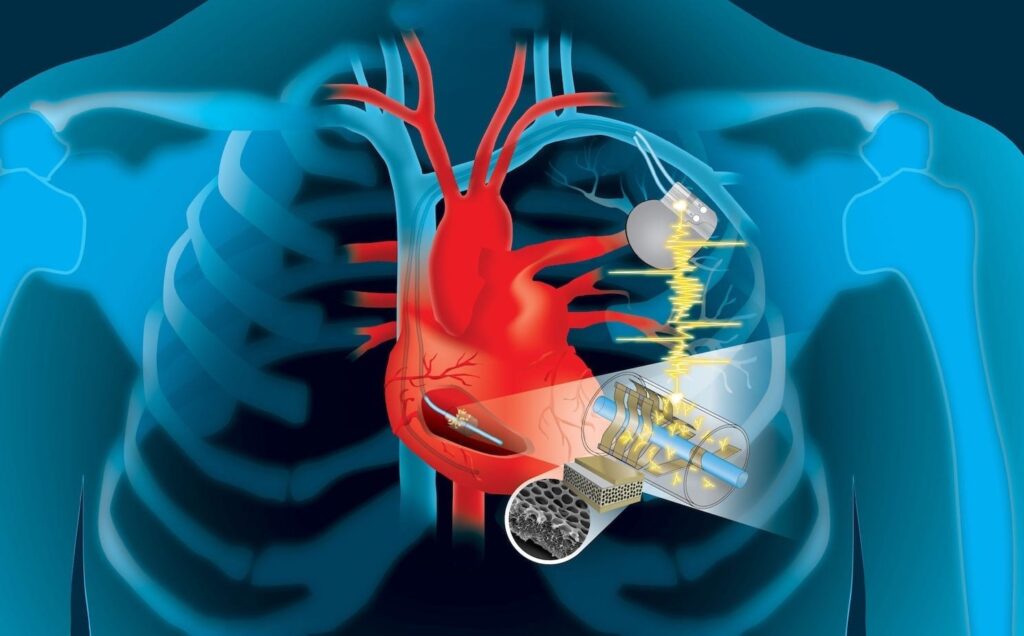
The heart’s motion is so powerful that it can recharge devices that save our lives, according to new research from Dartmouth College.
Using a dime-sized invention developed by engineers at the Thayer School of Engineering at Dartmouth, the kinetic energy of the heart can be converted into electricity to power a wide-range of implantable devices, according to the study funded by the National Institutes of Health.
Millions of people rely on pacemakers, defibrillators and other live-saving implantable devices powered by batteries that need to be replaced every five to 10 years. Those replacements require surgery which can be costly and create the possibility of complications and infections.
“We’re trying to solve the ultimate problem for any implantable biomedical device,” says Dartmouth engineering professor John X.J. Zhang, a lead researcher on the study his team completed alongside clinicians at UT Health San Antonio. “How do you create an effective energy source so the device will do its job during the entire life span of the patient, without the need for surgery to replace the battery?”
“Of equal importance is that the device not interfere with the body’s function,” adds Dartmouth research associate Lin Dong, first author on the paper. “We knew it had to be biocompatible, lightweight, flexible, and low profile, so it not only fits into the current pacemaker structure but is also scalable for future multi-functionality.”
The team’s work proposes modifying pacemakers to harness the kinetic energy of the lead wire that’s attached to the heart, converting it into electricity to continually charge the batteries. The added material is a type of thin polymer piezoelectric film called “PVDF” and, when designed with porous structures — either an array of small buckle beams or a flexible cantilever — it can convert even small mechanical motion to electricity. An added benefit: the same modules could potentially be used as sensors to enable data collection for real-time monitoring of patients.
The results of the three-year study, completed by Dartmouth’s engineering researchers along with clinicians at UT Health San Antonio, were just published in the cover story for Advanced Materials Technologies.
The two remaining years of NIH funding plus time to finish the pre-clinical process and obtain regulatory approval puts a self-charging pacemaker approximately five years out from commercialization, according to Zhang.
“We’ve completed the first round of animal studies with great results which will be published soon,” says Zhang. “There is already a lot of expressed interest from the major medical technology companies, and Andrew Closson, one of the study’s authors working with Lin Dong and an engineering PhD Innovation Program student at Dartmouth, is learning the business and technology transfer skills to be a cohort in moving forward with the entrepreneurial phase of this effort.”
Other key collaborators on the study include Dartmouth engineering professor Zi Chen, an expert on thin structure mechanics, and Dr. Marc Feldman, professor and clinical cardiologist at UT Health San Antonio.
Learn more: Engineers Harvest Heart’s Energy to Power Life-Saving Devices
The Latest on: Cardiac energy harvesting device
[google_news title=”” keyword=”cardiac energy harvesting device” num_posts=”10″ blurb_length=”0″ show_thumb=”left”]
via Google News
The Latest on: Cardiac energy harvesting device
- Energy harvester powers remote devices in the IoTon May 9, 2024 at 6:04 am
The pyroelectrochemical cell converts thermal energy into electricity and stores it. Source: Brian Maffly, University of Utah ...
- It May be Possible to Power Implantable Generators with Our Bodieson May 3, 2024 at 7:30 am
Researchers are trying to solve the problem of powering implantable devices to help improve and save lives.
- Exploiting disorder to harvest heat energy: The potentialities of 2D magnets for thermoelectric applicationson April 29, 2024 at 5:00 pm
Therefore, all mechanisms that increase such parameters can improve the conversion efficiency of the energy harvesting device. In 2D magnetic materials, two additional factors can alter the ...
- Devices for energy harvesting articles from across Nature Portfolioon April 25, 2024 at 5:00 pm
These solar cells can be integrated into a drone to enable energy-autonomous flight ... The full potential of photoelectric devices can possibly be maximized through pyroelectricity for power ...
- New device gathers, stores electricity in remote settingson April 8, 2024 at 5:00 pm
Wirelessly connected devices perform an expanding array of ... "We're talking very low levels of energy harvesting, but the ability to have sensors that can be distributed and not need to be ...
- Vein Harvesting for the Hearton April 3, 2024 at 4:20 pm
Matthew Thompson, a cardiac physician assistant at Saint ... The process, referred to as vein harvesting, has saved many lives but has an aesthetic down side: Doctors use a tiny fiber-optic ...
- Energy Harvestingon January 24, 2024 at 5:10 pm
and Shinohara, Naoki 2023. RF Energy Harvesting and Wireless Power Transfer for Energy Autonomous Wireless Devices and RFIDs. IEEE Journal of Microwaves, Vol. 3, Issue. 2, p. 763.
- energy harvestingon August 8, 2023 at 5:00 pm
Back in 1956, Seiko created their “magic lever” as an integral part of self-winding mechanical watches, which were essentially mechanical energy harvesters. The magic lever is a type of ...
- What are nanogenerators? Explaining their types, applications, and potentialon April 4, 2023 at 4:22 am
The electricity generated by triboelectric devices could replace or supplement batteries for a broad range of potential applications. Triboelectric nanogenerators have a broad range of applications, ...
- Energy Harvestingon February 21, 2023 at 11:17 pm
Vortex Bladeless uses a radically new approach to capturing wind energy. The device captures the energy ... are actively looking at energy harvesting to produce the electricity needed to power ...
via Bing News











